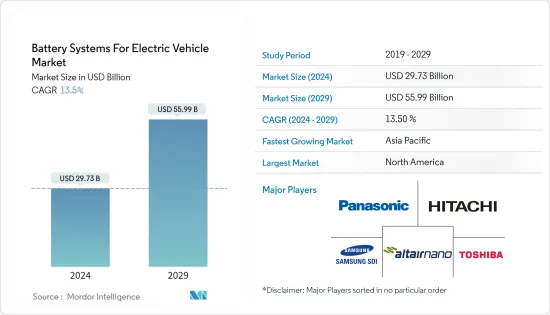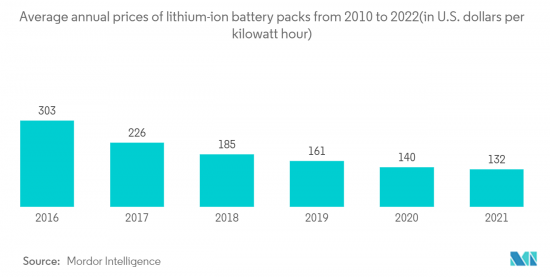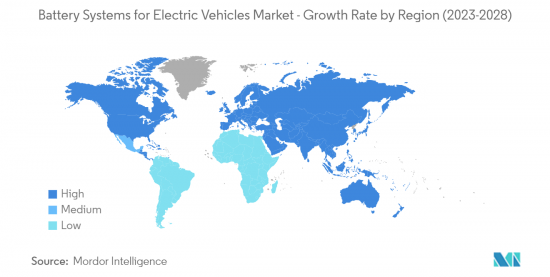 |
市场调查报告书
商品编码
1429218
电动汽车电池系统:市场占有率分析、产业趋势/统计、成长预测(2024-2029)Battery Systems For Electric Vehicle - Market Share Analysis, Industry Trends & Statistics, Growth Forecasts (2024 - 2029) |
||||||
※ 本网页内容可能与最新版本有所差异。详细情况请与我们联繫。
电动车电池系统市场规模预计2024年为297.3亿美元,预计2029年将达到559.9亿美元,在预测期内(2024-2029年)复合年增长率为13.5%增长。

主要亮点
- COVID-19大流行为电动车电池系统市场带来了前所未有的挑战。封锁措施和旅行限制扰乱了全球供应链,导致电池生产延误和短缺。製造设施和原材料供应链受到影响,影响了电动车的可用性和价格。经济不确定性、消费者支出减少和旅行限制导致电动车销量大幅下降。这种下滑直接影响了电池系统市场。
- 由于多种因素的影响,后疫情时期的电动车电池系统市场已经復苏并恢復了成长轨迹。世界各国政府继续优先考虑脱碳和永续交通。经济奖励策略和支持政策可能会实施以增加电动车的普及,这将推动对电池系统的需求。
- 随着全球经济復苏和监管放鬆,电动车的需求预计将復苏。消费者对永续性和环境意识的兴趣日益浓厚可能会促进电池系统市场的成长。持续的研发工作预计将带来电池技术的进步,包括更高的能量密度、更快的充电能力和更长的续航里程。这些进步提高了电动车的性能和吸引力,并推动了对电池系统的需求。
- 电池式电动车由汽车电池中储存的电力提供动力来源。电动车使用的汽车电池分为三种类型之一:镍氢电池、铅酸电池和锂离子电池。纯电动车中安装的二次电池组中储存的化学能驱动电动马达和马达控制器。
- 中国、美国、日本等已开发国家的主要政府正在投资电动车,这将为电动车电池系统市场提供巨大的成长机会。在预测期内,亚太地区和北美可能会主导市场。
电动车电池系统市场趋势
高成本和有限的续航里程阻碍了市场成长
- 有几个因素正在推动全球电池式电动车市场的发展,例如政府补贴和奖励。许多国家的政府以经济奖励的形式向纯电动车的购买者提供福利。这些奖励的金额通常取决于电池的大小。
- 例如,爱尔兰永续能源管理局(SEAI)向纯电动车购买者提供高达5,400美元的补贴,并免征车辆登记税。儘管电动车市场的电池不断增长,但它受到一些严峻挑战的限制。
- 电动汽车电池的续航里程和性能是市场的主要限制因素。电池通常被认为功率较弱且续航里程有限(一次充电 60-100 英里),因此仅适合短途旅行。由于电动车电池的续航里程有限,消费者担心在到达目的地之前就会耗尽电量或电力。
- 充电时间长也是市场面临的一大挑战。增压站的不可用也增加了与电动车电池使用相关的担忧。电动车中安装的电池的高成本也威胁着电池市场的成长,特别是整体电池式电动车的成长。例如,锂离子电池每可用千瓦时的成本在 500 美元至 650 美元之间,使其在车辆成本中占据很大一部分。

亚太市场加速成长
亚太地区电动车电池系统市场正在快速成长。该地区在这一领域不断增长的影响力背后有几个因素。中国、日本和韩国等国的电动车销量大幅成长。这些国家正在透过支持性政策、补贴和基础设施发展积极推动电动车的采用。亚太地区对电动车的需求不断增长,推动了对先进电池系统的需求。
- 例如,2023年5月,中国汽车製造商江淮汽车集团与高科技公司海钠电池合作开发了一款配备钠离子电池的电动车。
此外,亚太地区已成为电动车及其零件的主要製造地。该地区拥有强大的供应链和熟练的劳动力,使其成为电池系统製造商有吸引力的目的地。本地生产可降低生产成本并实现高效分销。亚太地区拥有多家创新电池技术公司和研究机构。这些公司致力于开发具有更高能量密度、更高安全性和更快充电能力的先进电池系统。对研发的重视促进了创新,使该地区处于电池系统进步的前沿。
此外,亚太地区各国政府正在认识到电动车和电池系统在实现永续交通目标方面的潜力。这些政府提供财政奖励、补贴和津贴,鼓励国内电池製造和研究。这些努力正在加速该地区电池系统市场的成长。亚太地区正在投资充电基础设施,以适应道路上不断增长的电动车数量。各国政府正在与私人公司合作安装充电站并部署智慧电网解决方案,以解决续航里程问题并改善整体电动车体验。这些基础设施的发展进一步推动了对电池系统的需求。
考虑到这些因素,与其他地区相比,亚太地区电动车电池系统市场的成长速度预计将更快。这为电池製造商、供应商和相关人员提供了利用快速成长的电动车市场的巨大机会。

电动汽车电池系统产业概况
主要供应商包括三星SDI、东芝公司、比亚迪、松下公司等。电动车电池製造商目前正在投资研发,以改善电池化学成分,以增加放电时间。
与传统铅酸或阀控式铅酸 (VRLA) 电池相比,锂离子电池的技术进步使其相对轻巧且持久耐用。由于电池式电动车车正在成为内燃机火车头最可行的替代品,同时也是排放问题的解决方案,预计在预测期内,此类车辆的需求将大幅增加,这为电动电池製造商提供了巨大的机会。
例如,瑞士新兴企业Morand 宣布了一项突破性电池技术,可将电动车的充电时间大幅缩短至约 72 秒。该公司的创新电动车电池采用混合系统,巧妙地将传统电池技术和超级电容器技术(称为电子技术)结合在一起。这种开创性的方法使电动车能够在短短 72 秒内实现令人难以置信的 80% 充电,并在短短 2.5 分钟内充满 100%。
其他福利:
- Excel 格式的市场预测 (ME) 表
- 3 个月的分析师支持
目录
第一章简介
- 调查先决条件
- 调查范围
第二章调查方法
第三章执行摘要
第四章市场动态
- 市场驱动因素
- 世界各国政府正在实施严格的法规并提供奖励以促进电动车的普及。
- 其他的
- 市场限制因素
- 初始成本高
- 其他的
- 产业吸引力-波特五力分析
- 新进入者的威胁
- 买家/消费者的议价能力
- 供应商的议价能力
- 替代品的威胁
- 竞争公司之间敌对关係的强度
第五章市场区隔
- 种类
- 锂离子电池
- 镍氢电池
- 铅酸蓄电池
- 超级电容器
- 其他的
- 车辆类型
- 小客车
- 商用车
- 地区
- 北美洲
- 美国
- 加拿大
- 墨西哥
- 其他北美地区
- 欧洲
- 德国
- 英国
- 法国
- 义大利
- 其他欧洲国家
- 亚太地区
- 中国
- 日本
- 印度
- 澳洲
- 其他亚太地区
- 南美洲
- 巴西
- 阿根廷
- 南美洲其他地区
- 中东/非洲
- 阿拉伯聯合大公国
- 沙乌地阿拉伯
- 其他中东和非洲
- 北美洲
第六章 竞争形势
- 供应商市场占有率
- 公司简介
- A123 Systems LLC
- Altairnano
- Boston-Power, Inc.
- Hitachi, Ltd.
- Johnson Controls International PLC
- LG Chem
- NEC Corporation
- Panasonic Corporation
- Toshiba Corporation
- Samsung SDI Co Ltd
第七章 市场机会及未来趋势
- 对远距电动车的需求不断增长
- 关注永续性和环境影响
- 电动车充电基础设施的成长
The Battery Systems For Electric Vehicle Market size is estimated at USD 29.73 billion in 2024, and is expected to reach USD 55.99 billion by 2029, growing at a CAGR of 13.5% during the forecast period (2024-2029).

Key Highlights
- The COVID-19 pandemic brought unprecedented challenges to the battery systems for the electric vehicles market. Lockdown measures and travel restrictions disrupted global supply chains, leading to delays and shortages in battery production. Manufacturing facilities and raw material supply chains were affected, impacting the availability and affordability of electric vehicles. Economic uncertainty, reduced consumer spending, and mobility restrictions resulted in a significant decline in electric vehicle sales. This decline directly impacted the battery systems market.
- The battery systems for electric vehicles market recovered and resumed its growth trajectory post-COVID due to several factors. Governments worldwide continue to prioritize decarbonization and sustainable transportation. Stimulus packages and supportive policies are likely to be implemented to boost the adoption of electric vehicles, which will drive the demand for battery systems.
- As the global economy recovers and restrictions ease, the demand for electric vehicles is expected to rebound. Consumers' increased focus on sustainability and environmental consciousness will contribute to the growth of the battery systems market. Continued research and development efforts will lead to advancements in battery technologies, including higher energy densities, faster charging capabilities, and longer ranges. These advancements will enhance the performance and attractiveness of electric vehicles, driving the demand for battery systems.
- Battery electric vehicles are powered by the electricity stored in the onboard battery. The onboard battery used in electric vehicles can be classified under one of the following three types: nickel metal hydride, lead-acid, and lithium-ion. The chemical energy stored in rechargeable battery packs installed in battery electric vehicles propels the electric motors and motor controllers.
- Major governments across developed countries, including China, the United States, and Japan, are investing in electric mobility, which is likely to provide significant growth opportunities for the battery system for electric vehicle market. Asia-Pacific and North America are likely to dominate the market during the forecast period.
Battery Systems for Electric Vehicles Market Trends
High Cost of Battery and Limited Driving Range Hindering the Market Growth
- Several factors, such as government subsidies and incentives, drive the global battery electric vehicles market. Governments in many countries have extended benefits in the form of financial incentives to the buyers of battery electric vehicles. The amount of these incentives usually depends on the size of the battery.
- For instance, the Sustainable Energy Authority of Ireland (SEAI) provides buyers of battery electric vehicles with grants of up to USD 5,400 and exempts them from vehicle registration tax. Despite the growth of the battery in the electric vehicles market, it is also curtailed by some serious challenges.
- The range and performance of the battery in electric vehicles are significant restraints for the market. The batteries are typically less powerful and have a limited range (60-100 miles per charge), and are considered suitable only for short-distance travel. The limited travel range of batteries of electric vehicles raises concerns among consumers that their vehicles may run out of charge/power before reaching their destination.
- Longer charging duration is another major challenge for the market. The lack of availability of supercharging stations adds to the woes associated with the use of batteries in an electric vehicle. The high cost of the battery in the electric vehicle also poses a threat to the growth of the battery market in particular and battery electric vehicles in general. For instance, the price per usable kilowatt-hour of a lithium-ion battery ranges from USD 500 to USD 650, and thus, makes up a large proportion of the vehicle's cost.

Asia-Pacific Market Growing at a Faster Pace
The Asia-Pacific region is indeed experiencing rapid growth in the battery systems for electric vehicles market. Several factors contribute to the region's increasing prominence in this sector. Countries like China, Japan, and South Korea have witnessed a substantial increase in electric vehicle sales. These nations are actively promoting the adoption of electric vehicles through supportive policies, subsidies, and infrastructure development. The rising demand for electric vehicles in the Asia-Pacific region drives the need for advanced battery systems.
- For instance, In May 2023, Chinese automaker JAC Group and tech company HiNa Battery teamed up to create an electric car powered by a sodium-ion battery.
Additionally, Asia-Pacific has emerged as a major manufacturing hub for electric vehicles and their components. The region boasts a robust supply chain and a skilled workforce, making it an attractive destination for battery system manufacturers. This localized manufacturing reduces production costs and allows for efficient distribution. The Asia-Pacific region is home to several innovative battery technology companies and research institutes. These entities are dedicated to developing advanced battery systems with higher energy density, improved safety, and faster charging capabilities. The emphasis on research and development fosters innovation and positions the region at the forefront of battery system advancements.
Moreover, governments in the Asia-Pacific region have recognized the potential of electric vehicles and battery systems in achieving sustainable transportation goals. They provide financial incentives, subsidies, and grants to promote domestic battery manufacturing and research. These initiatives accelerate the growth of the battery systems market in the region. The Asia-Pacific region is investing in the development of charging infrastructure to support the growing number of electric vehicles on the roads. Governments, in collaboration with private players, are establishing charging stations and implementing smart grid solutions to address range anxiety and enhance the overall EV experience. This infrastructure development further propels the demand for battery systems.
Considering these factors, the Asia-Pacific region is expected to witness a faster pace of growth in the battery systems for electric vehicles market compared to other regions. It offers significant opportunities for battery manufacturers, suppliers, and related stakeholders to capitalize on the burgeoning electric vehicle market.

Battery Systems for Electric Vehicles Industry Overview
The key vendors include Samsung SDI Co Ltd, Toshiba Corporation, BYD, and Panasonic Corporation, as they will be responsible for providing the automobile makers with the battery kit shortly. Currently, the battery manufacturers of electric vehicles are investing in R&D to improve the chemistry of the batteries to give a longer discharge time.
Technological advances in Li-ion batteries have made them comparatively lightweight with a long lifespan compared to conventional lead-acid and valve-regulated lead-acid battery (VRLA) batteries. With battery electric vehicles becoming the most viable alternative to ICE-powered automobiles and a solution to the problem of emissions, the demand for this type of vehicle is expected to increase considerably during the forecasted period, which calls for an excellent opportunity for electric battery manufacturers.
For instance, Swiss start-up Morand has introduced a groundbreaking battery technology that significantly reduces the charging time of electric vehicles to approximately 72 seconds. Their innovative EV battery utilizes a hybrid system, cleverly combining conventional battery technology with ultracapacitor technology, aptly named eTechnology. This pioneering approach allows electric vehicles to achieve an impressive 80% charge in a mere 72 seconds and complete a full 100% charge in just 2.5 minutes.
Additional Benefits:
- The market estimate (ME) sheet in Excel format
- 3 months of analyst support
TABLE OF CONTENTS
1 INTRODUCTION
- 1.1 Study Assumptions
- 1.2 Scope of the Study
2 RESEARCH METHODOLOGY
3 EXECUTIVE SUMMARY
4 MARKET DYNAMICS
- 4.1 Market Drivers
- 4.1.1 Governments worldwide are implementing strict regulations and providing incentives to promote the adoption of electric vehicles
- 4.1.2 Others
- 4.2 Market Restraints
- 4.2.1 High Initial Costs
- 4.2.2 Others
- 4.3 Industry Attractiveness - Porter's Five Force Analysis
- 4.3.1 Threat of New Entrants
- 4.3.2 Bargaining Power of Buyers/Consumers
- 4.3.3 Bargaining Power of Suppliers
- 4.3.4 Threat of Substitute Products
- 4.3.5 Intensity of Competitive Rivalry
5 MARKET SEGMENTATION
- 5.1 Type
- 5.1.1 Lithium-Ion Batteries
- 5.1.2 Nickel-Metal Hydride Batteries
- 5.1.3 Lead-Acid Batteries
- 5.1.4 Ultra capacitors
- 5.1.5 Others
- 5.2 Vehicle Type
- 5.2.1 Passenger Cars
- 5.2.2 Commercial Vehicles
- 5.3 Geography
- 5.3.1 North America
- 5.3.1.1 United States
- 5.3.1.2 Canada
- 5.3.1.3 Mexico
- 5.3.1.4 Rest of North America
- 5.3.2 Europe
- 5.3.2.1 Germany
- 5.3.2.2 United Kingdom
- 5.3.2.3 France
- 5.3.2.4 Italy
- 5.3.2.5 Rest of Europe
- 5.3.3 Asia-Pacific
- 5.3.3.1 China
- 5.3.3.2 Japan
- 5.3.3.3 India
- 5.3.3.4 Australia
- 5.3.3.5 Rest of Asia-Pacific
- 5.3.4 South America
- 5.3.4.1 Brazil
- 5.3.4.2 Argentina
- 5.3.4.3 Rest of South America
- 5.3.5 Middle-East and Africa
- 5.3.5.1 United Arab Emirates
- 5.3.5.2 Saudi Arabia
- 5.3.5.3 Rest of Middle-East and Africa
- 5.3.1 North America
6 COMPETITIVE LANDSCAPE
- 6.1 Vendor Market Share
- 6.2 Company Profiles
- 6.2.1 A123 Systems LLC
- 6.2.2 Altairnano
- 6.2.3 Boston-Power, Inc.
- 6.2.4 Hitachi, Ltd.
- 6.2.5 Johnson Controls International PLC
- 6.2.6 LG Chem
- 6.2.7 NEC Corporation
- 6.2.8 Panasonic Corporation
- 6.2.9 Toshiba Corporation
- 6.2.10 Samsung SDI Co Ltd
7 MARKET OPPORTUNITIES AND FUTURE TRENDS
- 7.1 Increasing Demand for Long-Range Evs
- 7.2 Focus on Sustainability and Environmental Impact
- 7.3 Growing Infrastructure for EV Charging













